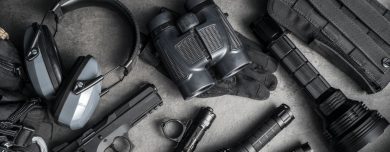
With tactical eyewear, safety is extremely important; so the design goes beyond its superficial looks and covers several layers of safety features to ensure that you do not sustain an eye injury while on duty. The primary focus when a manufacturer constructs a pair of tactical safety glasses is to ensure that the glasses do not break and that they shield your eyes from high-velocity projectiles during combat. Ensuring that the glasses are up to the task requires exposure to several safety tests as covered in our article on selecting the proper eyewear for use while on duty. But, what if you can’t see once you put the glasses on? In this case, all of the safety features aren’t effective because you cannot navigate effectively during wear. The manufacturers considered this when designing the glasses and have constructed several different lens tint colors to ensure you have clear vision at all times.
Lens Tint Choices
Many times, when you purchase a pair of tactical glasses, they come with several different lenses that are interchangeable within the frames. The most common colors included with a pair of tactical glasses are generally grey, pink, yellow and clear. With four different options to choose from, it is important to match your lens to the environment around you to ensure clear vision at all times. If you don’t know what you are doing, it is easy to simply choose a color at random and find yourself with distorted vision once you embark on your mission.
Why You Should Change the Lens Tint
Oftentimes, a pair of tactical glasses will arrive with the grey lenses attached to the frames. Many individuals will put the glasses on, leave the spare lenses in the case and never change the colored lenses throughout the life of the glasses. This is a big mistake. There is a reason four lenses come with a pair of tactical glasses, and there is also a reason that the grey lenses come attached to the frames. The grey lenses are frequently considered the ones that provide the truest color in sunny conditions while also shielding the eyes from bright light. These versatile lenses are great for bright and sunny days, but they fail to perform when the sun isn’t shining fully.
Indirect Light
For days when there is some cloud cover overhead or you find yourself working in indirect lighting conditions, the pink lenses will suit you best. They perform well when the sun is not at its brightest, but is still shining. These lenses improve definition, depth and general perception to ensure that you have a clear line of sight when lighting is somewhat limited. By eliminating any glare and cutting the brightness that your eyes are exposed to, these lenses ensure that your eyes do not fatigue over time so you are sharp and ready to go.
Low Light
When you find yourself working in a low-light setting, such as on a mission at dawn or dusk or in a dense wooded area, this is when you will want to use the yellow lenses. Yellow lenses work in the opposite way that you would expect a pair of “sunglasses” to function. Instead of darkening your field of view to cut brightness to a tolerable level, yellow lenses actually brighten your field of vision to create more detail when light is scarce. With more detail, you are more easily able to pick out objects at a distance.
Eye Protection
Finally, many pairs of tactical glasses will include a pair of clear lenses. These lenses protect your eyes from projectiles without altering your vision at all. Clear lenses are best suited for wear at night or inside – whether at a shooting range or on a tactical mission. With no contrast in your natural vision, these lenses provide clear lines of sight with no distortion. Clear lenses are also favored when the individual wearing them is simultaneously using a form of tactical optics – whether it is night vision or otherwise.
With so many lens options in tactical eyewear nowadays, it is easy to find yourself wearing the wrong lens tint as you head out in the field on a mission. Familiarize yourself with the functionality of each lens tint to ensure that you have uninhibited vision when the bullets start flying and the pressure is on.
Disclaimer: The content in this article is the opinion of the writer and does not necessarily reflect the policies or opinions of US Patriot Tactical.






